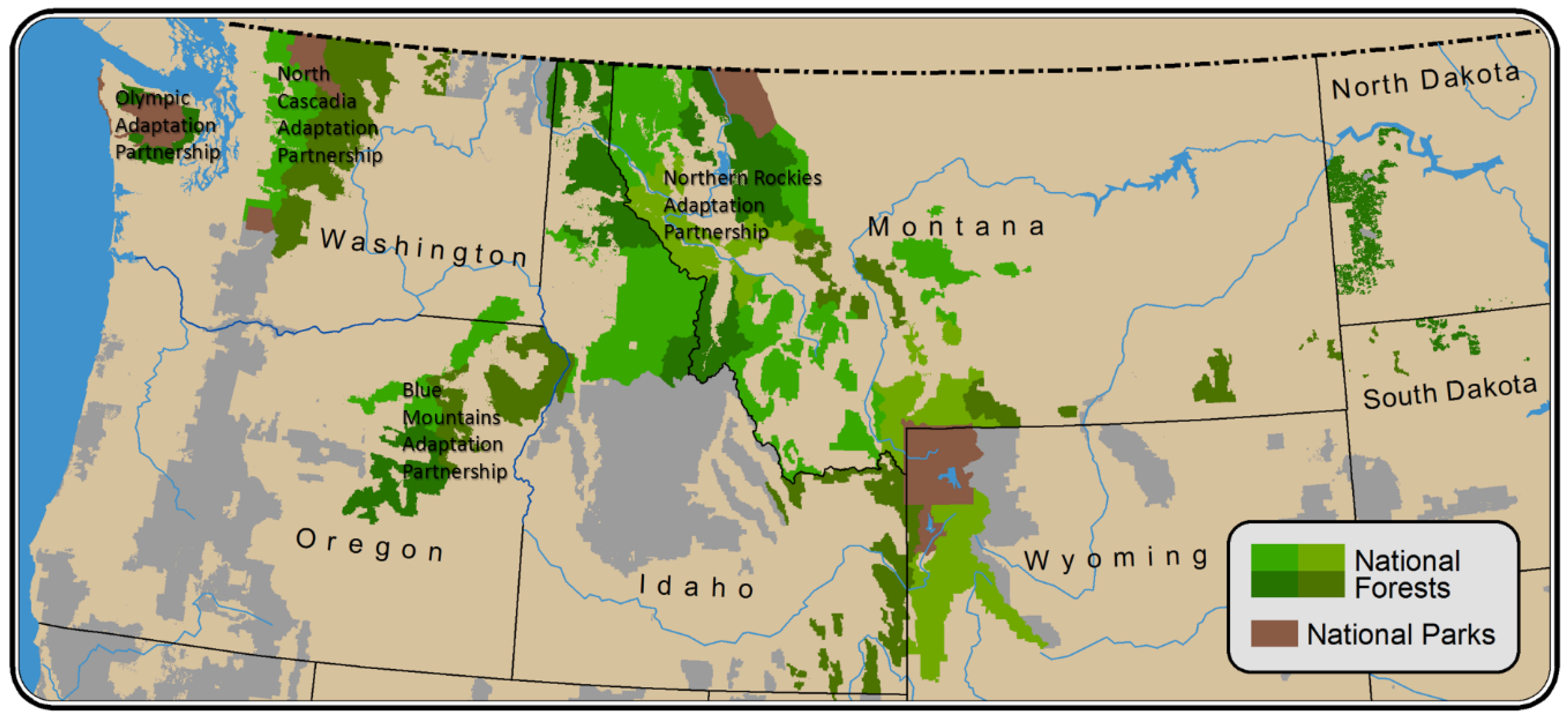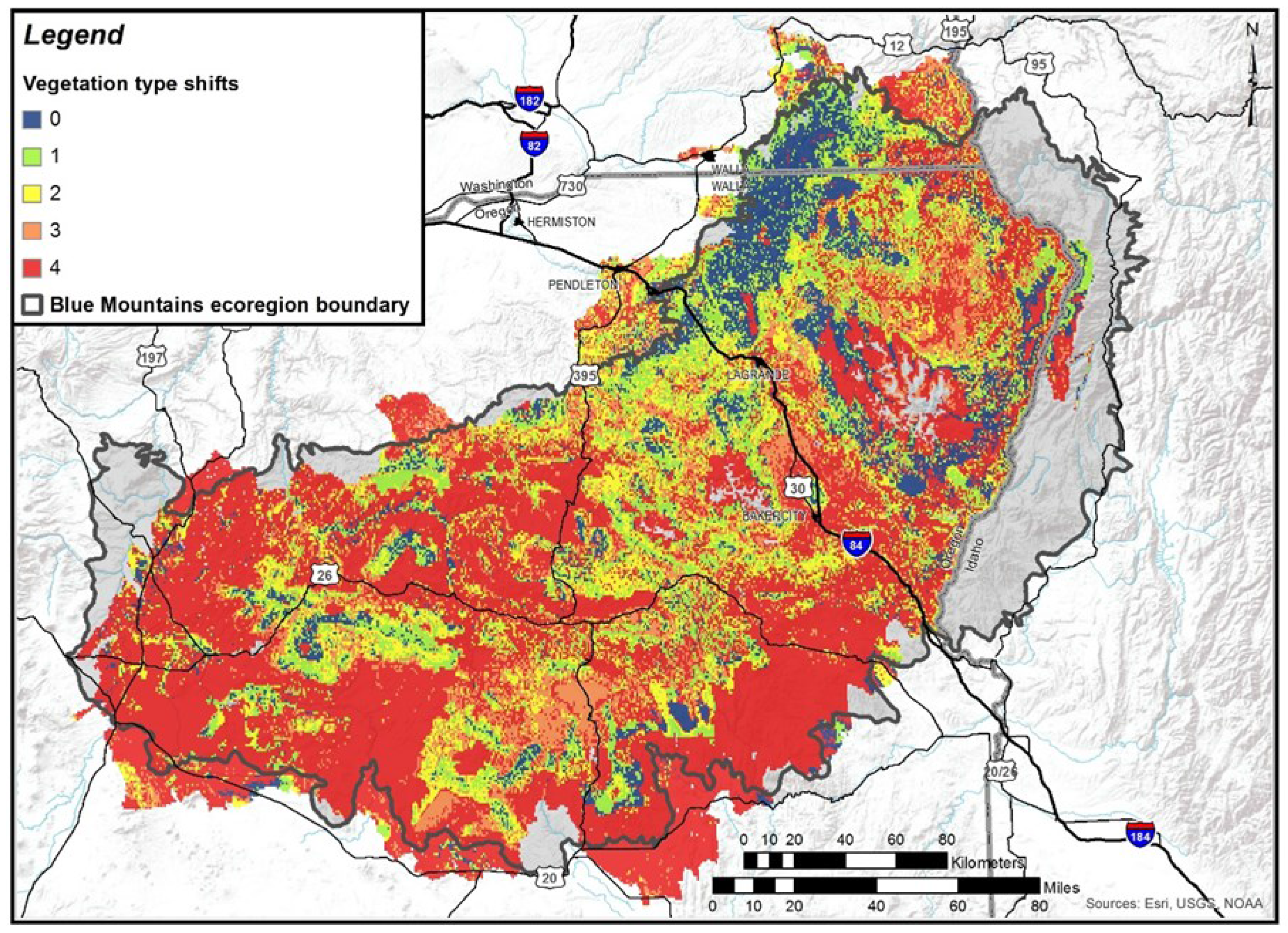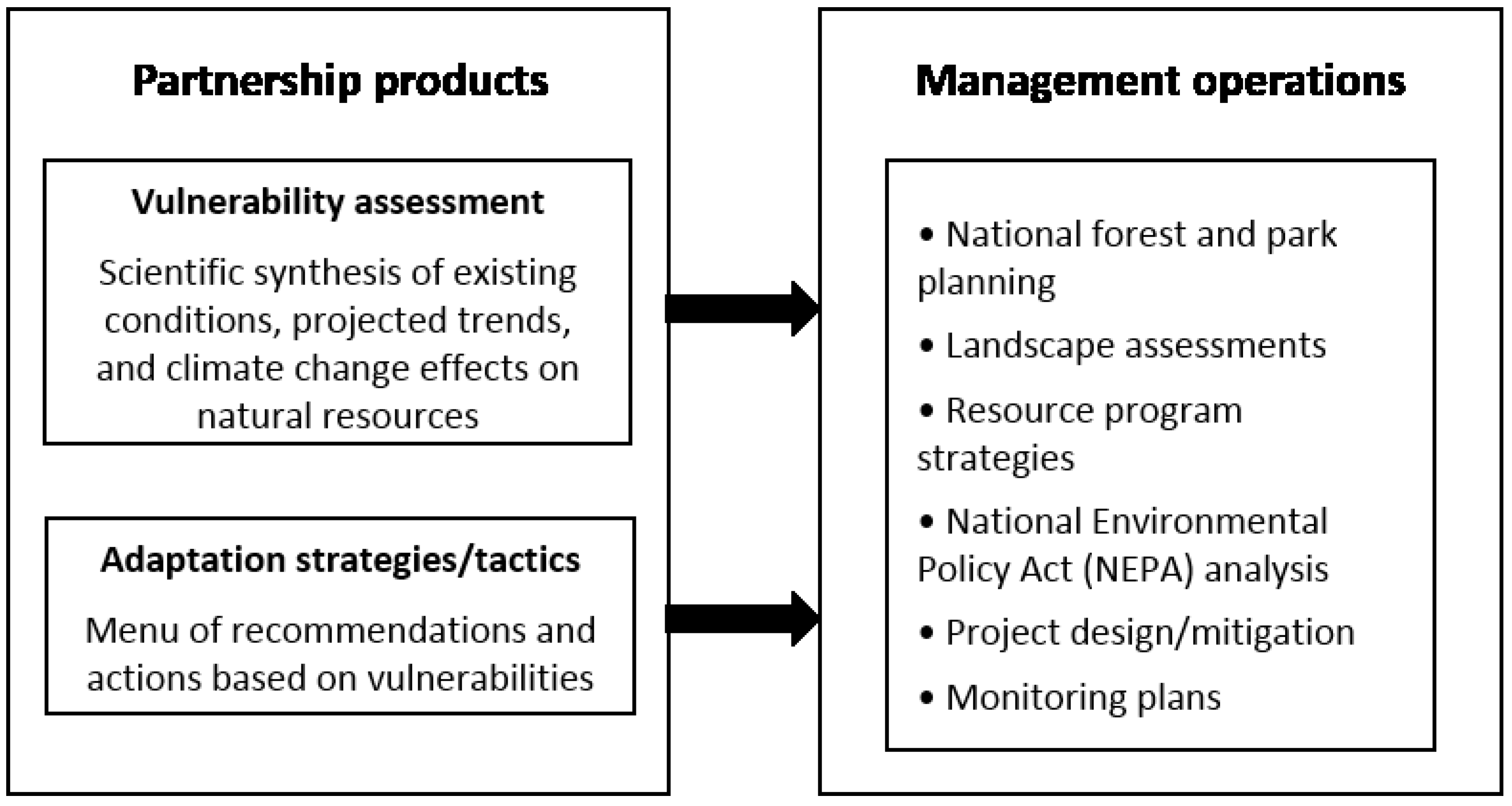Climate Change Vulnerabilities and Adaptation Options for Forest Vegetation Management in the Northwestern USA
Abstract
:1. Introduction
2. Assessment and Adaptation Process
3. Results and Discussion
3.1. Effects on Vegetation
3.2. Effects on Ecological Disturbances
3.3. Adaptation Options
4. Conclusions
- National forest/national park planning: Overarching resource plans required for all national forests and national parks are the highest level of implementation of climate change information. These plans tier down to all other planning and management functions in the federal agencies.
- Landscape management assessments: Vulnerability assessments provide information on departure from desired conditions and best science on effects of climate change on resources for inclusion in long-term assessments. Adaptation strategies and tactics provide desired conditions, objectives, standards, and guidelines for federal planning.
- Resource management strategies: Vulnerability assessments and adaptation options are used to incorporate best science in conservation strategies, fire management plans, infrastructure planning, and State Wildlife Action Plans.
- National Environmental Policy Act analysis: Vulnerability assessments provide best available science for documentation of resource conditions, effects analysis, and alternatives development. Adaptation strategies and tactics provide mitigation and design tactics at specific locations.
- Project design: Vulnerability assessments and adaptation options guide the development and implementation of vegetation management and restoration projects, helping to modify “standard” practice with “climate smart” actions.
- Monitoring plans: Vulnerability assessments help identify knowledge gaps that can be addressed by monitoring in broad-scale strategies, plan-level programs, and project-level data collection.
Acknowledgments
Author Contributions
Conflicts of Interest
References
- Littell, J.S.; Hicke, J.A.; Shafer, S.L.; Capalbo, S.M.; Houston, L.L.; Glick, P. Forest ecosystems: Vegetation, disturbance, and economics. In Climate Change in the Northwest: Implications for Our Landscapes, Waters, and Communities; Dalton, M.M., Mote, P.W., Snover, A.K., Eds.; Island Press: Washington, DC, USA, 2013; pp. 110–148. [Google Scholar]
- Ayres, M.P.; Hicke, J.A.; Kerns, B.K.; McKenzie, D.; Littell, J.S.; Band, L.E.; Luce, C.H.; Weed, A.S.; Raymond, C.L. Disturbance regimes and stressors. In Climate Change and United States Forests, Advances in Global Change Research; Peterson, D.L., Vose, J.M., Patel-Weynand, T., Eds.; Springer: Dordrecht, The Netherlands, 2014; pp. 55–92. [Google Scholar]
- Keenan, R.J. Climate change impacts and adaptation in forest management: A review. Ann. For. Sci. 2015, 72, 145–167. [Google Scholar] [CrossRef]
- Halofsky, J.E.; Peterson, D.L.; Marcinkowski, K.W. Climate change adaptation in United States federal natural resource science and management agencies: A synthesis. U.S. Global Change Research Program: Washington, DC, USA, 2015. Available online: http://www.globalchange.gov/browse/reports/climate-change-adaptation-united-states-federal-natural-resource-science-and (accessed on 11 December 2015). [Google Scholar]
- Bierbaum, R.; Smith, J.B.; Lee, A.; Blair, M.; Carter, L.; Chapin, F.S., III; Fleming, P.; Ruffo, S.; Stults, M.; McNeeley, S.; et al. A comprehensive review of climate adaptation in the United States: More than before, but less than needed. Mitig. Adapt. Strategies Glob. Change 2013, 18, 361–406. [Google Scholar] [CrossRef]
- Peterson, D.L.; Millar, C.I.; Joyce, L.A.; Furniss, M.J.; Halofsky, J.E.; Neilson, R.P.; Morelli, T.L. Responding to Climate Change on National Forests: A Guidebook for Developing Adaptation Options; General Technical Report PNW-GTR-855; U.S. Department of Agriculture, Forest Service, Pacific Northwest Research Station: Portland, OR, USA, 2011. [Google Scholar]
- Littell, J.S.; Peterson, D.L.; Millar, C.I.; O’Halloran, K. U.S. national forests adapt to climate change through science-management partnerships. Clim. Change 2012, 110, 269–296. [Google Scholar] [CrossRef]
- McCarthy, P.D. Climate change adaptation for people and nature: A case study from the U.S. southwest. Adv. Clim. Change Res. 2012, 3, 22–37. [Google Scholar] [CrossRef]
- Swanston, C.; Janowiak, M. (Eds.) Forest Adaptation Resources: Climate Change Tools and Approaches for Land Managers; Gen. Tech. Rep. NRS-87; U.S. Department of Agriculture, Forest Service, Northern Research Station: Newtown Square, PA, USA, 2012.
- Cross, M.S.; McCarthy, P.D.; Garfin, G.; Gori, D.; Enquist, C.A. Accelerating adaptation of natural resource management to address climate change. Conserv. Biol. 2013, 27, 4–13. [Google Scholar] [CrossRef] [PubMed]
- Halofsky, J.E.; Peterson, D.L.; Joyce, L.A.; Millar, C.I.; Rice, J.M.; Swanston, C.W. Implementing climate change adaptation in forested regions of the United States. In Forest Conservation and Management in the Anthropocene; Sample, V.A., Bixler, R.P., Eds.; U.S. Department of Agriculture, Forest Service, Rocky Mountain Research Station: Fort Collins, CO, USA, 2014; pp. 229–243. [Google Scholar]
- Intergovernmental Panel on Climate Change [IPCC]. Climate Change 2007: Impacts, Adaptation, and Vulnerability; Contribution of Working Group II to the Fourth Assessment Report of the Intergovernmental Panel on Climate Change; Parry, M.L., Canziani, O.F., Palutikof, J.P., van der Linden, P.J., Hanson, C.E., Eds.; Cambridge University Press: Cambridge, UK, 2007. [Google Scholar]
- Mote, P.W.; Salathé, E.P., Jr. Future climate in the Pacific Northwest. In The Washington Climate Change Impacts Assessment; University of Washington, Climate Impacts Group, Joint Institute for the Study of the Atmosphere and Oceans, Center for Science in the Earth System: Seattle, Washington, USA, 2009; Chapter 1; pp. 21–43. [Google Scholar]
- Littell, J.S. Future climate on the Olympic Peninsula: Forest-relevant climate scenarios. In Adapting to Climate Change at Olympic National Forest and Olympic National Park; PNW-GTR-844; Halofsky, J.E., Peterson, D.L., O’Halloran, K.A., Hawkins Hoffman, C., Eds.; U.S. Department of Agriculture Forest Service, Pacific Northwest Research Station: Portland, Oregon, USA, 2011; pp. 13–20. [Google Scholar]
- Littell, J.S.; Raymond, C.L. Climate and climate change in the North Cascade Range. In Climate Change Vulnerability and Adaptation in the North Cascades Region, Washington; PNW-GTR-892; Raymond, C.L., Peterson, D.L., Rochefort, R.M., Eds.; U.S. Department of Agriculture Forest Service, Pacific Northwest Research Station: Portland, OR, USA, 2011; pp. 25–44. [Google Scholar]
- Mote, P.; Abatzoglou, J.; Kunkel, K. Climate change and variability in the past and future. In Climate Change in the Northwest: Implications for Our Landscapes, Waters and Communities; Dalton, M.M., Mote, P.W., Snover, A.K., Eds.; Island Press: Washington, DC, USA, 2013; pp. 25–40. [Google Scholar]
- Clifton, C.F.; Day, K.T.; Dello, K.; Grant, G.E.; Halofsky, J.E.; Isaak, D.J.; Luce, C.H.; Safeeq, M.; Staab, B.P.; Stevenson, J. Climate change and hydrology in the Blue Mountains. In Climate Change Vulnerability and Adaptation in the Blue Mountains; Halofsky, J.E., Peterson, D.L., Eds.; U.S. Department of Agriculture Forest Service, Pacific Northwest Research Station: Portland, OR, USA, 2016; in press. [Google Scholar]
- Joyce, L.A.; Talbert, M.; Sharp, D.; Morisette, J.; Stevenson, J. Historical and projected climate in the Northern Rockies Adaptation Partnership region. In Climate Change Vulnerability and Adaptation in the Northern Rockies; Halofsky, J.E., Peterson, D.L., Eds.; U.S. Department of Agriculture Forest Service, Rocky Mountain Research Station: Fort Collins, CO, USA, 2016; in press. [Google Scholar]
- Stocker, T.F.; Qin, D.; Plattner, G.-K.; Tignor, M.; Allen, S.K.; Boschung, J.; Nauels, A.; Xia, Y.; Bex, V.; Midgley, P.M. (Eds.) Climate Change 2013: The Physical Science Basis; Contribution of Working Group I to the Fifth Assessment Report of the Intergovernmental Panel on Climate Change; Cambridge University Press: Cambridge, UK; New York, NY, USA, 2013.
- Bachelet, D.; Lenihan, J.M.; Daly, C.; Neilson, R.P.; Ojima, D.S.; Parton, W.J. MC1: A Dynamic Vegetation Model for Estimating the Distribution of Vegetation and Associated Ecosystem fluxes of Carbon, Nutrients, and Water: Technical Documentation Version 1.0. PNW-GTR-508; U.S. Department of Agriculture, Forest Service, Pacific Northwest Research Station: Portland, OR, USA, 2001. [Google Scholar]
- Millar, C.I.; Stephenson, N.L.; Stephens, S.L. Climate change and forests of the future: Managing in the face of uncertainty. Ecol. Appl. 2007, 17, 2145–2151. [Google Scholar] [CrossRef] [PubMed]
- Halofsky, J.E.; Peterson, D.L.; Aubry, C.; Dowling, C.; Acker, S.A. Climate change and vegetation management at Olympic National Forest and Olympic National Park. In Adapting to climate change at Olympic National Forest and Olympic National Park; PNW-GTR-844; Halofsky, J.E., Peterson, D.L., O’Halloran, K.A., Hawkins Hoffman, C., Eds.; U.S. Department of Agriculture Forest Service, Pacific Northwest Research Station: Portland, OR, USA, 2011; pp. 61–90. [Google Scholar]
- Littell, J.S.; Raymond, C.L.; Rochefort, R.M.; Klein, S.L. Climate change and vegetation in the North Cascade Range. In Climate Change Vulnerability and Adaptation in the North Cascades Region, Washington; PNW-GTR-892; Raymond, C.L., Peterson, D.L., Rochefort, R.M., Eds.; U.S. Department of Agriculture Forest Service, Pacific Northwest Research Station: Portland, OR, USA, 2011; pp. 113–176. [Google Scholar]
- Kerns, B.K.; Powell, D.C.; Mellmann-Brown, S.; Carnwath, G.; Kim, J.B. Effects of climatic variability and change on upland vegetation in the Blue Mountains. In Climate Change Vulnerability and Adaptation in the Blue Mountains; Halofsky, J.E., Peterson, D.L., Eds.; U.S. Department of Agriculture Forest Service, Pacific Northwest Research Station: Portland, OR, USA, 2016; in press. [Google Scholar]
- Keane, R.E.; Mahalovich, M.F.; Bollenbacher, B.; Manning, M.; Loehman, R.; Jain, T.; Holsinger, L.; Larson, A.; Webster, M. Forest vegetation. In Climate Change Vulnerability and Adaptation in the Northern Rockies; Halofsky, J.E., Peterson, D.L., Eds.; U.S. Department of Agriculture Forest Service, Rocky Mountain Research Station: Fort Collins, CO, USA, 2016; in press. [Google Scholar]
- Latta, G.; Temesgen, H.; Adams, D.; Barrett, T. Analysis of potential impacts of climate change on forests of the United States Pacific Northwest. For. Ecol. Manag. 2010, 259, 720–729. [Google Scholar] [CrossRef]
- Hu, J.; Moore, D.J.P.; Burns, S.P.; Monson, R.K. Longer growing seasons lead to less carbon sequestration by a subalpine forest. Glob. Change Biol. 2010, 16, 771–783. [Google Scholar] [CrossRef]
- Temperli, C.; Veblen, T.T.; Hart, S.J.; Kulakowski, D.; Tepley, A.J. Interactions among spruce beetle disturbance, climate change and forest dynamics captured by a forest landscape model. Ecosphere 2015, 6, 231. [Google Scholar] [CrossRef]
- Peterson, D.W.; Peterson, D.L. Mountain hemlock growth responds to climatic variability at annual and decadal time scales. Ecology 2001, 82, 3330–3345. [Google Scholar] [CrossRef]
- Elsner, M.M.; Cuo, L.; Voisin, N.; Deems, J.S.; Hamlet, A.F.; Vano, J.A.; Lettenmaier, D.P. Implications of 21st century climate change for the hydrology of Washington State. Clim. Change 2010, 102, 225–260. [Google Scholar] [CrossRef]
- Littell, J.S.; Peterson, D.L.; Tjoelker, M. Douglas-fir growth in mountain ecosystems: Water limits tree growth from stand to region. Ecol. Monogr. 2008, 78, 349–368. [Google Scholar] [CrossRef]
- Littell, J.S.; Oneil, E.E.; McKenzie, D.; Hicke, J.A.; Lutz, J.A.; Norheim, R.A.; Elsner, M.M. Forest ecosystems, disturbance, and climatic change in Washington State, USA. Clim. Change 2010, 102, 129–158. [Google Scholar] [CrossRef]
- Adams, H.D.; Macalady, A.K.; Breshears, D.D.; Allen, C.D.; Stephenson, N.L.; Saleska, S.R.; Huxman, T.E.; McDowell, N.G. Climate-induced tree mortality: Earth system consequences. Eos 2010, 91, 153–154. [Google Scholar] [CrossRef]
- Anderegg, W.R.L.; Anderegg, L.D.L.; Sherman, C.; Karp, D.S. Effects of widespread drought-induced aspen mortality on understory plants. Conserv. Biol. 2012, 26, 1082–1090. [Google Scholar] [CrossRef] [PubMed]
- Westerling, A.L.; Hidalgo, H.G.; Cayan, D.R.; Swetnam, T.W. Warming and earlier spring increase western U.S. forest wildfire activity. Science 2006, 313, 940–943. [Google Scholar] [CrossRef] [PubMed]
- Westerling, A.L.; Turner, M.G.; Smithwick, E.A.H.; Romme, W.H.; Ryan, M.G. Continued warming could transform Greater Yellowstone fire regimes by mid-21st century. Proc. Natl. Acad. Sci. USA 2011, 108, 13,165–13,170. [Google Scholar] [CrossRef] [PubMed]
- McKenzie, D.; Gedalof, Z.; Peterson, D.L.; Mote, P. Climatic change, wildfire, and conservation. Conser. Biol. 2004, 18, 890–902. [Google Scholar] [CrossRef]
- Bentz, B.J.; Jönsson, A.M. Modeling bark beetle responses to climate change. In Bark Beetles: Biology and Ecology of Native and Invasive Species; Vega, F., Hofstetter, R., Eds.; Elsevier: London, UK, 2015; pp. 543–549. [Google Scholar]
- Safranyik, L.; Carroll, A.; Régnière, J.; Langor, D.W.; Riel, W.G.; Shore, T.L.; Peter, B.; Cooke, B.J.; Nealis, V.G.; Taylor, S.W. Potential for range expansion of mountain pine beetle into the boreal forest of North America. Can. Entomol. 2010, 142, 415–442. [Google Scholar] [CrossRef]
- Hellmann, J.J.; Byers, J.E.; Bierwagen, B.G.; Dukes, J.S. Five potential consequences of climate change for invasive species. Conserv. Biol. 2008, 22, 534–543. [Google Scholar] [CrossRef] [PubMed]
- Diez, J.M.; D’Antonio, C.M.; Dukes, J.S.; Grosholz, E.D.; Olden, J.D.; Sorte, C.J.B.; Blumenthal, D.M.; Bradley, B.A.; Early, R.; Ibáñez, I.; et al. Will extreme climatic events facilitate biological invasions? Front. Ecol. Environ. 2012, 10, 249–257. [Google Scholar] [CrossRef]
- Dukes, J.S.; Mooney, H.A. Does global change increase the success of biological invaders? Trends Ecol. Evol. 1999, 14, 135–139. [Google Scholar] [CrossRef]
- McKenzie, D.; Peterson, D.L.; Littell, J.J. Global warming and stress complexes in forests of Western North America. Dev. Env. Sci. 2008, 8, 319–337. [Google Scholar] [CrossRef]
- Ziska, L.H.; Teasdale, J.R. Sustained growth and increased tolerance to glyphosate observed in a C3 perennial weed, quackgrass (Elytrigia repens), grown at elevated carbon dioxide. Aust. J. Plant Physiol. 2000, 27, 159–166. [Google Scholar] [CrossRef]
- Dymond, C.C.; Sinclair, T.; Spittlehouse, D.L.; Raymer, B. Diversifying managed forests to increase resilience. Can. J. For. Res. 2014, 44, 1196–1205. [Google Scholar] [CrossRef]
- Stephens, S.L.; Millar, C.I.; Collins, B.M. Operational approaches to managing forests of the future in Mediterranean regions within a context of changing climates. Environ. Res. Lett. 2010, 5, 1–9. [Google Scholar] [CrossRef]
- Spies, T.A.; Giesen, T.W.; Swanson, F.J.; Franklin, J.F.; Lach, D.; Johnson, K.N. Climate change adaptation strategies for federal forests of the Pacific Northwest, USA: Ecological, policy, and socio-economic perspectives. Landsc. Ecol. 2010, 25, 1185–1199. [Google Scholar] [CrossRef]
- Stein, B.A.; Staudt, A.; Cross, M.S.; Dubois, N.S.; Enquist, C.; Griffis, R.; Hansen, L.J.; Hellmann, J.J.; Lawler, J.J.; Nelson, E.J.; et al. Preparing for and managing change: Climate adaptation for biodiversity and ecosystems. Front. Ecol. Environ. 2013, 11, 502–510. [Google Scholar] [CrossRef]
- Adaptation Partners. Climate change adaptation library for the Western United States. Available online: http://adaptationpartners.org/library.php (accessed on 17 March 2016).



| Vulnerability to Climate Change | Adaptation Strategy | Adaptation Tactic |
|---|---|---|
| The distribution of subalpine forests is likely to shift as a result of increasing temperatures with climate change | Monitor and detect change in seedling survival, species composition, and mortality of mature trees in subalpine forests |
|
| Increased forest drought stress and decreased forest productivity at lower elevations | Increase resilience in forests |
|
| Protect genotypic and phenotypic diversity |
| |
| Maintain and enhance forest productivity regardless of tree species; focus on functional ecosystems and processes |
| |
| Use tree improvement programs to ensure availability of drought tolerant tree species and genotypes |
| |
| More fire (larger aerial extent and more high-severity patches) and more area in recently burned or early-successional stages | Plan and prepare for greater area burned |
|
| Increase resilience of existing vegetation by reducing hazardous fuels and forest density and maintain low densities |
| |
| Manage forest landscapes to encourage fire to play a natural role |
| |
| Increased warming, drought and wildfire will reduce tree vigor and increase susceptibility to insects and pathogens with increased potential for large and extensive insect and pathogen outbreaks, particularly of non-native insects and pathogens | Increase resilience of forest stands to disturbance by increasing tree vigor |
|
| Increase forest landscape resilience to large and extensive insect or pathogen outbreaks |
| |
| Promote diversity of forest age and size classes |
| |
| Revegetate with native plant species |
| |
| Increased opportunity for exotic species establishment with dry forest habitats potentially more susceptible | Increase exotic species control efforts |
|
| Prevent exotic plants from establishing after disturbances |
| |
| Prevent widespread outbreaks of exotic species or pathogens |
| |
| Increase resilience by promoting native genotypes and adapted genotypes of native species |
| |
| Maintain integrity of native plant populations and prevent exotic species invasions |
|
© 2016 by the authors; licensee MDPI, Basel, Switzerland. This article is an open access article distributed under the terms and conditions of the Creative Commons by Attribution (CC-BY) license (http://creativecommons.org/licenses/by/4.0/).
Share and Cite
Halofsky, J.E.; Peterson, D.L. Climate Change Vulnerabilities and Adaptation Options for Forest Vegetation Management in the Northwestern USA. Atmosphere 2016, 7, 46. https://doi.org/10.3390/atmos7030046
Halofsky JE, Peterson DL. Climate Change Vulnerabilities and Adaptation Options for Forest Vegetation Management in the Northwestern USA. Atmosphere. 2016; 7(3):46. https://doi.org/10.3390/atmos7030046
Chicago/Turabian StyleHalofsky, Jessica E., and David L. Peterson. 2016. "Climate Change Vulnerabilities and Adaptation Options for Forest Vegetation Management in the Northwestern USA" Atmosphere 7, no. 3: 46. https://doi.org/10.3390/atmos7030046
APA StyleHalofsky, J. E., & Peterson, D. L. (2016). Climate Change Vulnerabilities and Adaptation Options for Forest Vegetation Management in the Northwestern USA. Atmosphere, 7(3), 46. https://doi.org/10.3390/atmos7030046





